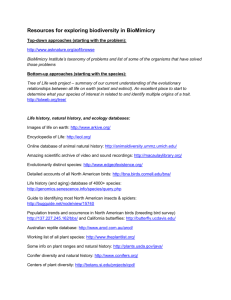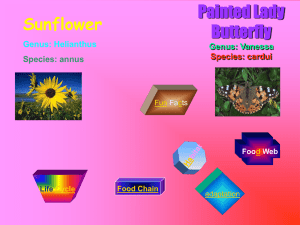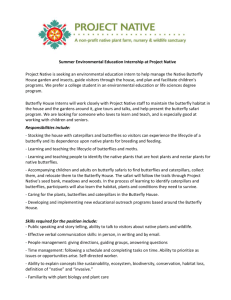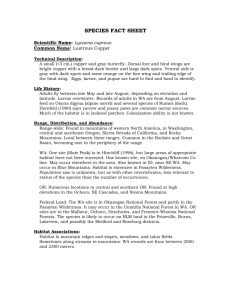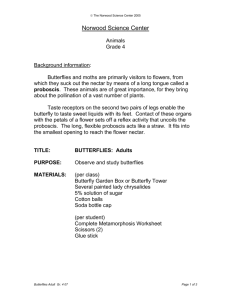Zoo Licence Application
advertisement
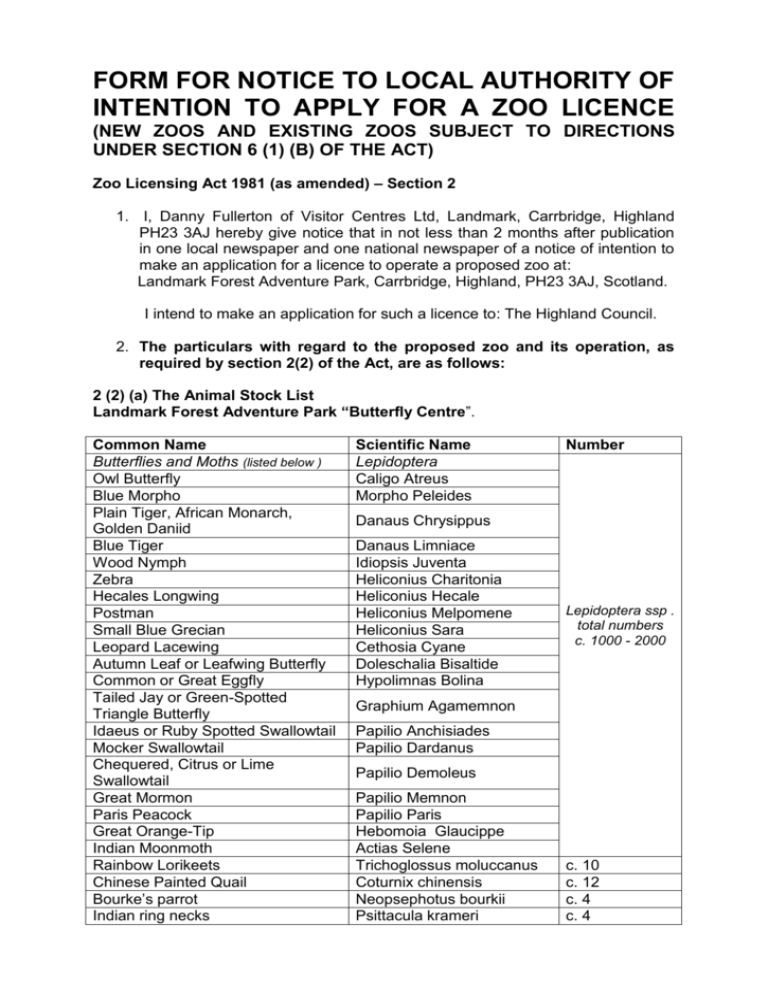
FORM FOR NOTICE TO LOCAL AUTHORITY OF INTENTION TO APPLY FOR A ZOO LICENCE (NEW ZOOS AND EXISTING ZOOS SUBJECT TO DIRECTIONS UNDER SECTION 6 (1) (B) OF THE ACT) Zoo Licensing Act 1981 (as amended) – Section 2 1. I, Danny Fullerton of Visitor Centres Ltd, Landmark, Carrbridge, Highland PH23 3AJ hereby give notice that in not less than 2 months after publication in one local newspaper and one national newspaper of a notice of intention to make an application for a licence to operate a proposed zoo at: Landmark Forest Adventure Park, Carrbridge, Highland, PH23 3AJ, Scotland. I intend to make an application for such a licence to: The Highland Council. 2. The particulars with regard to the proposed zoo and its operation, as required by section 2(2) of the Act, are as follows: 2 (2) (a) The Animal Stock List Landmark Forest Adventure Park “Butterfly Centre”. Common Name Butterflies and Moths (listed below ) Owl Butterfly Blue Morpho Plain Tiger, African Monarch, Golden Daniid Blue Tiger Wood Nymph Zebra Hecales Longwing Postman Small Blue Grecian Leopard Lacewing Autumn Leaf or Leafwing Butterfly Common or Great Eggfly Tailed Jay or Green-Spotted Triangle Butterfly Idaeus or Ruby Spotted Swallowtail Mocker Swallowtail Chequered, Citrus or Lime Swallowtail Great Mormon Paris Peacock Great Orange-Tip Indian Moonmoth Rainbow Lorikeets Chinese Painted Quail Bourke’s parrot Indian ring necks Scientific Name Lepidoptera Caligo Atreus Morpho Peleides Number Danaus Chrysippus Danaus Limniace Idiopsis Juventa Heliconius Charitonia Heliconius Hecale Heliconius Melpomene Heliconius Sara Cethosia Cyane Doleschalia Bisaltide Hypolimnas Bolina Lepidoptera ssp . total numbers c. 1000 - 2000 Graphium Agamemnon Papilio Anchisiades Papilio Dardanus Papilio Demoleus Papilio Memnon Papilio Paris Hebomoia Glaucippe Actias Selene Trichoglossus moluccanus Coturnix chinensis Neopsephotus bourkii Psittacula krameri c. 10 c. 12 c. 4 c. 4 Cockatiel Speckled Mouse birds Gold Fish Nymphicus hollandicus Colius striatus Carassius auratus c. 2 c. 6 c. 20 No dangerous species of any type (as per the Dangerous Wild Animals Act 1976) will be kept. No species will be kept which are listed as endangered/ IUCN Red listed or CITES. Give brief details of the animal accommodation to be provided (i.e. the number, type, approximate size and security of enclosure, including confined quarters during the night and winter, and the grouping of animals). [Note – if preferred, this information may be submitted in the form of annotated drawings or plans. In any event, a plan showing the proposed layout of the zoo should be submitted]. TROPICAL BUTTERFLY, BIRD ZONE All butterflies and birds will be housed in a two-part heated and humidified, highspecification, hot house with twin wall PTFE and galvanised steel frame construction and reception area of wood or aluminium frame with double-glazed panels or double skin PTFE panels linked by access doorway. Total area will be in the order of 400 square metres and capacity of over 1000 cubic metres. There will be a fish pool for a small number of gold fish. Heating will be provided by Air-Source heat pumps. Butterflies and birds will be free ranging within the heated areas. Pupae will be housed in special display and emergence cabinets within or adjacent to the flight zone. The gold fish will be held in a suitably sized, filtered and temperature controlled indoor pond. All inhabitants will be free-ranging within the centre and will have appropriate daytime rest perches and evening roost or shelter provided. Security will be strictly observed and all exit possibilities will be double protected to prevent escape. Mirrors will be provided to allow self-checking of clothing before guests exit. It is not planned to keep any species that could survive outside the hot house and controlled feed environment provided – any escapees- although none are envisaged – will quickly succumb to cold and or lack of food. Existing protocols and careful choice of species as pioneered in a great many other similar centres will ensure low to zero possibility of escape while ensuring zero risk of local environmental impact. In winter it is intended to retain only the birds, fish and plants due to the impracticability of running the centre with butterflies at the high heat differentials and natural sunlight requirements at the location. Temperature would be maintained at a suitable level for the bird and fish population at all times throughout the year. Back up heating plant will be provided and will be automatically triggered in event of a temperature drop. The back-up plant will be independently resourced from the main plant as a fail-safe measure. Special planting of appropriate botanical species to reflect the home environment(s) of the butterflies and birds will be provided and maintained. Handling of all species without staff present to monitor and instruct guests will be positively discouraged by clear signage. Unavoidable butterfly landings will occur and guests will be informed how to avoid wing or other damage during such landings. Rainbow Lorikeets are a gregarious species and are happy to feed from nectar pots. We plan to have feeding sessions where guests can hold the pots while the birds feed. Staff will lead the sessions where this will be encouraged and managed with the welfare of the birds as top priority. This has been pioneered at many zoos around the world and is seen as a good opportunity to introduce wildlife at close quarters and to shape attitudes and build bonds between wildlife and humans. Care will be taken to ensure that procedures relating to amounts of food and care of handling are strictly observed so that the birds are not stressed or over fed. A plan of the “Butterfly Centre” is attached as an addendum to this application. Maintenance and well-being Give brief details of arrangements to be made for the animals’ maintenance and well-being, including information about the provision, storage and preparation of food and arrangements for veterinary care, including preventative measures. For supplies of all the pupae the following providers will be used: Stratford Butterfly Farm and The London Pupae Exchange Both suppliers are fully licenced, compliant and obtain pupae from sustainable verified sources and all pupae are screened for quality and disease on despatch at point of origin, at arrival in the UK and before being put into ‘emergence cabinets’ in the Butterfly Centre. All butterflies will arrive as pupae initially. It will be an objective of the Centre to breed certain species as is the case in other UK centres. Pupae will be inspected for any signs of disease or other issues before being mounted in emergence cabinet or displayed. Any showing such signs will be immediately quarantined and destroyed. In such cases suppliers will be notified. Birds and fish will be sourced from licenced UK breeders. Butterflies and moths will have appropriate species-relevant food distributed throughout the free-range area. This will be a mix of suitable plants, cut fruits and nectar, and pollen producing flowers. Bird species will have a mixture of food according to the species. For instance Rainbow Lorikeets will have nectar and fruits, Parakeets and Quail will have seed, fruit and vegetables as appropriate to the sub species. All food storage will be on site in pest-proof refrigerated or dry containers. Staff will be fully trained in species husbandry, and basic care and well-being will be part of the training of all attendants. A locally appointed vet will be on call for all incidents of disease injury or illness. The Management of Landmark will work closely with the appointed vet to ensure the best practice in health and welfare of all the inhabitants of the “Butterfly Centre” and further to ensure best possible practice in every aspect of operating the Centre. Cleaning procedures will ensure there is no build-up of dangerous levels of decaying material or pathogens harmful to the animal and humans. A quarantine area will be established for birds and fish showing signs of illness and the vet alerted. Inevitably animals with short life spans will die in the centre during periods when guests are present – this will be explained in the interpretive material and in any staff/guest interaction. Ill, diseased or dead butterflies will be removed during regular walk throughs. This will be a continual staff duty. Clearly dying or ill butterflies will be euthanised following highly ethical procedures by freezing. The Centre will be designed to ensure as far as possible all the inhabitants’ requirements are met. Mr Ben Hayes, Company Director, has a wealth of experience of the relevant welfare and environmental requirements. As an operator of two Butterfly Centres abroad, in Cambodia and Zanzibar, including highly organised local breeding programmes, and with field experience dating over 20 years, he is very well placed to advise and input at every stage of the design, build and operation of the Centre. Day books and check lists will be kept detailing all key observations and inspections. A standard operation manual will be in place for every aspect of running the Centre from animal well-being to plant maintenance to dealing with difficult members of the public. Emergency procedures will be fully detailed and any relevant drills practiced. In particular safety procedures for staff, guests and animals will be in place for predictable emergencies. All staff will be trained thoroughly in the appropriate areas of the Standard Operations so procedures and protocols are consistently followed and all appropriate recording is meticulously carried out. All plant, equipment and buildings will be added to our Computer Aided Facilities Management software programme providing a very structured planned maintenance as well as reactive maintenance and repair capability. Butterfly Centre Staff will be supported by general Park Staff and will be in both telephone and radio contact at all times. In addition, ongoing advice and consultancy from pupae suppliers and in particular Stratford upon Avon Butterfly Farm will be maintained. Staff Training will be continuous with input from external expert resources. The company is currently in process of joining the Lead Body for Butterfly Centres (The International Association of Butterfly Exhibitors and Suppliers) When the centre is closed it will be securely locked. CCTV will be operational at appropriate stations. Staff will be detailed to care for the centre during any period that the park has to make unplanned closures. Pest Control: The centre will have a pest control procedure using bio-control methods as used in other Butterfly Centres. Hygiene facilities will be in place for staff and guest at an appropriate level and will include as a minimum hand wash stations. Section 2 (2) (b) Staff Numbers and Categories Give details of the numbers and categories of staff to be employed in the zoo (i) Senior administrative staff under director/manager Four administrative staff in existing office (ii) Other administrative staff Nil (iii) Keeper Staff Two full time equivalent attendant/keeper/maintenance staff and 3 assistants available from pool of 100 Landmark Staff as and when required (iv) Maintenance Staff Existing back up maintenance squad of ten available at all times during the year (v) Others (please specify) Director-level consultancy and advice always available from Mr Ben Hayes, Company Director. Interpretation/guiding expertise and training from Directors and Landmark Management team ensuring high level conservation and the social enterprise/human dimension is well featured in interpretive materials. (c) Section 2 (2) (c) Visitors and Motor Vehicles (i) Approximate number of visitors who are to be accommodated per day Peak visitor numbers will be as at present – 2000 to 2500 guests per day with daily average over the year of around 400 – 500. Motor vehicles will be accommodated within the current car park within the Landmark site (ii) Type and size of car-parking facilities (if any) 900 space hard standing car park areas within the Landmark Forest Park site (d) Section 2 (2) (d) Access Give details of the approximate number and position of the means of access to be provided to the premises. [Note – if preferred this information may be submitted in the form of an annotated drawing or plan]. Vehicle access from Main Street entrance to Landmark Forest Adventure Park Car Park. Pedestrian access from existing maintained pathways throughout the Landmark Site. (e) Section (2A) Conservation Measures Please specify and provide details of how the conservation measures referred to in section 1A of the Zoo Licensing Act 1981 (Amendment) Regulations 2002 are being or will be implemented at the zoo. Refer to section 1A of Act The following are conservation measures to be implemented in zoos in accordance with this Act— (A) Participating in at least one of the following— (i) Research from which conservation benefits accrue to species of wild animals; (ii) Training in relevant conservation skills; (iii) The exchange of information relating to the conservation of species of wild animals; The Butterfly Centre will have as one of its core tenets the education of guests in as far as it is possible within this type of small scale operation. The interpretive plan will focus on explaining: Biodiversity and inter-relationship and interdependency of species The life cycles of Moths and Butterflies. Natural habitats and the importance of habitat conservation for diversity Human activity – how some activity adversely impacts on sustainability of habitat Human activity – accounts of the successful examples of sustainable social/ecological enterprises – Ben Hayes’ experience in founding and operating Butterfly farming and centres in Cambodia and Zanzibar. Our mutual responsibility for Nature Conservation as being among the top priorities for our survival and the survival of the planet. Where appropriate the Centre will participate in the exchange of information, in as far as possible, in the academic sphere. The centre will outline the local context in relation to Butterflies in conjunction with the key organisations active in the field. Encouraging guests to consider joining relevant organisation will be another key goal of the centre. (iv) Where appropriate, breeding of wild animals in captivity; We do not envisage breeding of animals in captivity at the butterfly centre. and (v) Where appropriate, the repopulation of an area with, or the reintroduction into the wild of, wild animals; N/A (B) Promoting public education and awareness in relation to the conservation of biodiversity, in particular by providing information about the species of wild animals kept in the zoo and their natural habitats; See A (iii) above for examples of subject contained within the interpretive plan. Interpretive techniques and resources will vary but will include for instance: static displays of text and Illustration; Interactive electronic displays including quizzes, video, games and so on appropriate to the audience; interaction with staff and from time to time invited experts in the field including but not limited to talks and tours; Interaction/feeding of Rainbow Lorikeets and using the opportunity to impart knowledge about the adaptations of the bird and its speciality feeding and so on. (C) Accommodating their animals under conditions which aim to satisfy the biological and conservation requirements of the species to which they belong, including: (i) Providing each animal with an environment well adapted to meet the physical, psychological and social needs of the species to which it belongs; See Section entitled ‘Maintenance and Wellbeing’ above. Each animal will be free ranging with large amounts of space for flying, roosting, resting all in an appropriate climate and environment designed to replicate their natural habitat. Consideration will be given at design and operating stages to the psychological well-being and to the social needs of the animals. In addition, consideration will be given to the minimum and maximum population guidelines for bird species to ensure social harmony. The centre will employ the most recent techniques for enrichening the environment for the animals including the best practice for feeding locations and encouraging of natural behaviour patterns. (ii) Providing a high standard of animal husbandry with a developed programme of preventative and curative veterinary care and nutrition; See the section on Maintenance and well-being above. (D) Preventing the escape of animals and putting in place measures to be taken in the event of any escape or unauthorised release of animals; All exits will be ‘air-lock types with an additional plastic flap barrier. Mirrors will be positioned at each exit with signage asking guests to check themselves for butterflies on their clothing before leaving. The nature of exotic butterflies is that they will not fly far if the temperature is lower than their preferred temperature. In the event of escape it is envisaged that they will be collected and returned very soon. If they are not recaptured their ability to survive low evening temperatures in the local area is zero. There is no escapee impact envisaged on the local environment. Birds will be very unlikely to be able to escape the entry/exit barriers. If it is the case that there is an escape staff will endeavour to attract the bird back to the centre using food and other bids as bait and netting to capture. Given the specialist diet it is envisaged that any escaped birds will either return for food or eventually will succumb to hunger. Birds will be encouraged to be happy to come to humans so recapturing any escaper will be made more likely. (e) Preventing the intrusion of pests and vermin into the zoo premises; Entry and exit systems will prevent entry of the cast majority of pests and vermin. Main pests of concern will be more likely to be aphids, greenfly, moulds and fungi. Appropriate bio precautions and measures will be in force to minimise the effects these may have. (f) Keeping up-to-date records of the zoo’s collection, including records of— (i) The numbers of different animals; All arrivals of pupae will be logged. All arrivals of birds will be logged and regular counts taken and recorded. (ii) Acquisitions, births, deaths, disposals and escapes of animals; A register of all stock arrivals will be kept. In the case of butterflies it will not be possible to register all deaths. For birds a full record of arrival, a regular count and including a record of death or removal to another site including all medical treatment and attendance at veterinary premises. All birds will be ringed with identification details on arrival. A day book will also be kept and entries will log all relevant events including temperatures, humidity, attention needed, actions taken, incidents (including breakdown and repair of plant and equipment); public incidents; as well as routine and non-routine operations. Any escapes will be recorded and followed up with ‘recapture’ or ‘failure to recapture’ and ‘current status as known’ data logged. (iii) The causes of any such deaths; For butterflies this will only be possible in the event of an outbreak of an affective disease. This will then be recorded as part of our response to such an outbreak – appropriate action will be taken in light of the nature of the incident. For birds - all deaths will be recorded as will the cause. All non-natural deaths of birds will also be cause for responsive action depending on the reason. Veterinary advice will be taken and followed in such circumstances. (iv) The health of the animals. See section on ‘Maintenance and well-being’ above.


